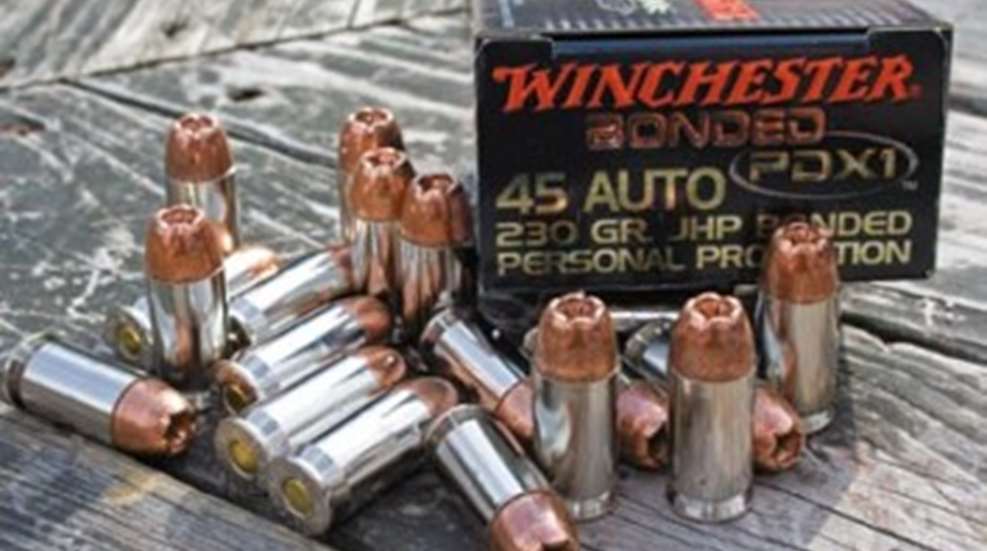
Winchester designed the bullet used in the PDX1 line to provide the best aggregate performance over the broad range of tests to which the FBI subjects handgun ammunition. The FBI's terminal-ballistic testing protocol evaluates a bullet's ability to pass through various intermediate barriers—from light clothing to automobile glass—and still expand and penetrate to a depth necessary to damage vital organs.
The Winchester PDX1 line includes a 147-grain 9 mm load, a 124-grain 9 mm +P load, 165- and 180-grain .40 S&W loads, a 230-grain .45 ACP load and a 130-grain .38 Spl. +P load. A proprietary bonding process controls expansion and keeps the copper-alloy jacket welded to the hard, lead-alloy core, enabling the bullet to retain all or most of its weight regardless of the intermediate barriers or bone it may encounter. As a matter of fact, Winchester loads its PDX1 ammo with the Ranger Bonded bullet—the same bullet that the company uses in its 180-grain .40 S&W Ranger Bonded load—selected by the FBI as its primary service round.
The ability to defeat intermediate barriers is important to law enforcement officers because they rarely shoot bad guys who are naked. Of course, this applies to law-abiding citizens as well. Your assailant is unlikely to be in his birthday suit and could very possibly end up behind some sort of obstacle before you're able to stop the threat.
Expansion is important because it increases crush-cavity volume. The crush cavity is equal to the radius of the expanded bullet squared, multiplied by pi and the depth of penetration. Since defensive handgun bullets don't impact at velocities fast enough to create substantial damage beyond the crush cavity, the expanded frontal diameter is a key indicator of how much tissue they can damage. That said, if a bullet expands too much, penetration will be sacrificed. Ideal expansion is between 1.5 and 1.7 times the original diameter with near 100 percent weight retention. A high percentage of weight retention ensures adequate penetration.
At the 2009 SHOT Show, I attended a range demonstration that involved putting PDX1 personal-defense handgun ammunition through four of the eight tests that are part of the current FBI testing protocol. During these tests, the ammo performed very well. The 180-grain .40 S&W load was the only one tested in Orlando, but soon after I returned home I received 80 rounds of 124-grain 9 mm +P and 80 rounds of 230-grain .45 ACP to test on my own.
First, I fired five, five-shot groups with each load from a sandbag rest at 25 yards to establish accuracy potential. I then fired two rounds of each load into CorBin SimTest and one round each into Defensive Handgun Test Tubes. Remaining ammo was run through a CZ 75 and a Kimber Warrior to check functioning.
Both loads were very accurate, averaging 2 inches. I experienced no malfunctions, which can likely be attributed to the fact PDX1 is loaded in nickel-plated cases and because Winchester used a proven bullet profile. Using 10-percent ordnance gelatin conversion factors I have established for various testing mediums, I'll bet both loads perform on par with the .40 S&W load showcased at the SHOT Show.
I'd also be willing to bet a counterfeit dollar to a cop's doughnut that Winchester will sell quite a lot of PDX1 ammunition to folks looking for a reliable load for their defensive handgun. The PDX1 is substantially better ammunition than some of the law enforcement-only ammunition I carried when I was still a cop, and I would not hesitate to fill the magazine of a handgun to which I intended to trust my life with PDX1.
Shooting Results FBI Testing Protocol Results
Winchester Bonded PDX1 180 grain .40 S&W
| Barrier | Velocity | Penetration | Rcovered Weight | Recovered Diameter |
| None | 998 | 10.75 | 180 | .831 |
| Denim | 1,000 | 12.00 | 180 | .742 |
| Wallboard | 1,027 | 11.25 | 180 | .750 |
| Auto glass | 998 | 12.00 | 165 | .690 |
| Velocity measured in fps at the muzzle and provided by Winchester. Penetration measured in inches. Recovered weight measured in grains. Recovered diameter measured in inches. | ||||
| Load | Velocity | Test Medium | Penetration | 10-percent GelatinConversion Penetration | Recovered Weight | Recovered Diameter |
| 124-grain 9 mm +P | 1,256 | Bullet Test Tube | 5.82 | 10.58 (+/- 1 inch) | 124.00 | .62 |
| 230-grain .45 ACP | 908 | Bullet Test Tube | 6.22 | 11.31 (+/- 1 inch) | 230.00 | .72 |
| 124-grain 9 mm +P | 1,247* | Corbin SimTest | 5.02* | 10.68 (+/- 1 inch) | 124.00* | .58 |
| 230-grain .45 ACP | 889* | Corbin SimTest | 5.31* | 11.29 (+/- 1 inch) | 229.70* | .66 |
| Velocity measured in fps at the muzzle for one shot, unless noted. Penetration measured ininches. Recovered weight measured in grains. Recovered diameter measured in inches. *Averagefor two shots. | ||||||
| Load | Velocity | Largest Group | Smallest Group | Average |
| 124-grain 9 mm +P | 1,258 | 3.01 | 1.33 | 2.07 |
| 230-grain .45 ACP | 890 | 2.95 | 1.59 | 2.00 |
| Velocity measured in fps at the muzzle and is the average of 25 consecutive shots. Accuracy measured in inches for five consecutive, five-shot groups from a sandbag rest at 25 yards. | ||||





































